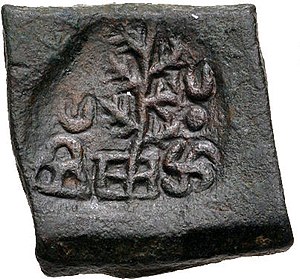
The Post-Mauryan coinage of Gandhara refers to the period of coinage production in Gandhara, following the breakup of the Maurya Empire (321-185 BCE). When Mauryan central power disappeared, several small independent entities were formed, which started to strike their own coins, defining a period of Post-Mauryan coinage that ends with the rise of the Gupta Empire in the 4th century CE. This phenomenon was particularly precocious and significant in the area of Gandhara in the northwest, and more particularly in the city of Taxila,[2] in modern-day Pakistan.
- ^ "CNG Coins coin notice". Archived from the original on 2016-12-20. Retrieved 2016-12-12.
- ^ The Coins Of India, by Brown, C.J. p.13-20
